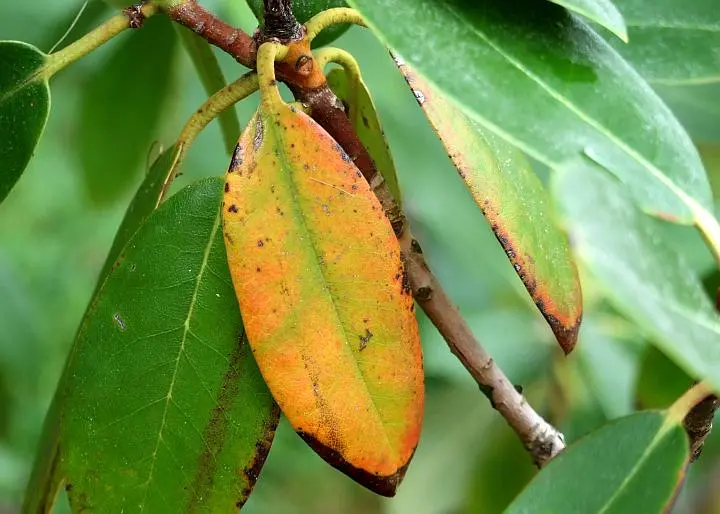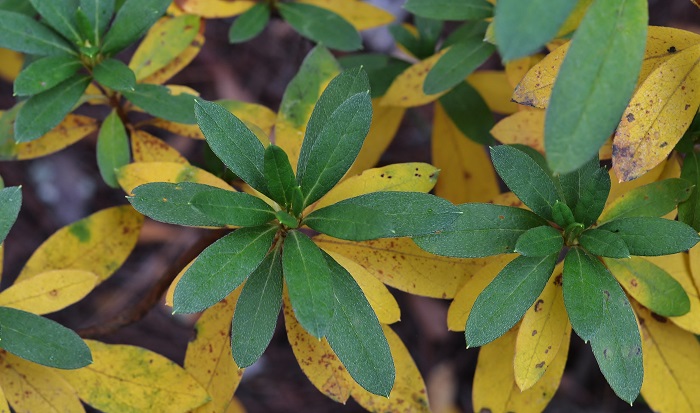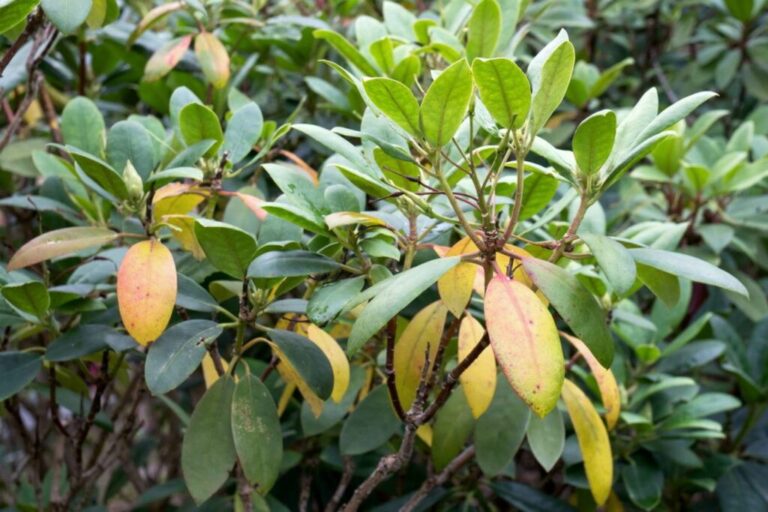Yellowing leaves on rhododendrons can result from various issues. It’s often due to factors like improper soil pH (preferably acidic), causing nutrient absorption problems. Inconsistent watering either too much or too little can stress the plant, leading to leaf discoloration. Nutrient deficiencies, particularly iron and magnesium, may manifest as yellowing leaves. Poor drainage can suffocate roots, while pests like lace bugs or diseases such as root rot can also cause discoloration.
Environmental stressors like harsh sunlight or extreme temperatures might contribute to leaf yellowing. To address this, ensure proper soil pH, adjust watering practices, apply suitable fertilizers, improve drainage, check for pests or diseases, and shield the plant from extreme environmental conditions.
What are Rhododendrons?

Rhododendrons are a genus of flowering plants that belong to the family Ericaceae. These plants are known for their beautiful clusters of large, showy flowers and their broad, evergreen leaves.
Furthermore, there are over a thousand species of rhododendrons, ranging from shrubs to small trees, and they are distributed across various regions, including Asia, Europe, North America, and Australia.
These plants are popular in gardens and landscapes due to their stunning flowers, which come in various colors such as pink, purple, red, white, and yellow. Rhododendrons typically bloom in spring, although flowering times can vary based on the species and climate.
Rhododendrons prefer acidic soils and thrive in areas with partial shade or dappled sunlight. They require well-draining soil and adequate moisture for optimal growth. Some species of rhododendrons are also known for their ability to tolerate colder climates.
These plants have cultural significance in different parts of the world. For instance, in some regions of Asia, rhododendrons have been used in traditional medicine, while in Western cultures, they are mainly appreciated for their ornamental value in gardens and parks.
It’s important to note that while rhododendrons are admired for their beauty, some species contain toxins, particularly in their leaves and nectar, which can be harmful if ingested by humans and animals. Therefore, caution should be exercised when planting them, especially in areas accessible to pets or children.
How Do Rhododendron Leaves Turn Yellow?
Rhododendron leaves can turn yellow due to various factors, and understanding these causes can help address the issue effectively. Here are some common reasons why rhododendron leaves might turn yellow:
Nutrient Deficiency
Yellowing leaves could be a sign of nutrient deficiencies, particularly nitrogen or iron. Lack of these essential nutrients can lead to chlorosis, causing the leaves to turn yellow. Ensuring the plant is receiving proper fertilization with a balanced fertilizer designed for acid-loving plants can help mitigate this issue.
pH Imbalance
Rhododendrons prefer acidic soil. If the soil pH is too high (alkaline), it can hinder the plant’s ability to absorb nutrients, leading to yellowing leaves. Testing the soil’s pH and amending it, if necessary, with acidifying agents like sulfur can help maintain the ideal pH level for rhododendrons.
Watering Issues
Overwatering or underwatering can stress the plant and cause yellowing leaves. Poor drainage leading to waterlogged roots can lead to root rot and yellow leaves.
Conversely, insufficient watering can also stress the plant and result in leaf discoloration. It’s essential to water rhododendrons consistently, ensuring the soil is moist but not waterlogged.
Pests or Diseases
Certain pests, such as lace bugs or spider mites, can infest rhododendrons, causing damage to the leaves and leading to yellowing. Additionally, diseases like phytophthora root rot can affect the plant’s health, causing leaves to turn yellow or brown. Proper pest control measures and disease management strategies are necessary to address these issues.
Environmental Stress
Environmental factors like excessive heat, direct sunlight, or harsh winds can stress rhododendrons, causing their leaves to yellow. Providing adequate shade, mulching around the base, and protecting the plant from extreme conditions can help alleviate stress.
Inspecting the plant thoroughly, checking the soil, assessing watering practices, and examining for pests or diseases can help identify the specific cause of yellowing leaves in rhododendrons. Once the cause is determined, appropriate corrective measures can be taken, such as adjusting watering schedules, applying fertilizers, improving soil conditions, or treating pests or diseases, to help the plant regain its health and vibrant foliage.
How to Diagnose Yellowing Leaves on Rhododendrons?

Yellowing leaves on rhododendrons can be caused by various factors, and diagnosing the exact cause involves considering several possibilities. Here are some common reasons for yellowing leaves on rhododendrons and steps to diagnose the issue:
Nutrient Deficiency
Yellowing usually starts in older leaves and progresses to younger leaves. Leaves may turn yellow between the veins, indicating a nutrient deficiency.
Conduct a soil test to check for nutrient imbalances. Rhododendrons prefer acidic soil with a pH between 4.5 and 6.0. Lack of essential nutrients like nitrogen, iron, or magnesium can cause yellowing.
Improper Soil pH
Rhododendrons prefer acidic soil. If the soil is too alkaline, it can lead to yellowing leaves.
Test the soil pH using a soil pH testing kit. If the pH is too high, consider amending the soil with sulfur or other acidifying agents.
Watering Issues
Both overwatering and underwatering can cause yellowing leaves. Overwatered plants may have yellow leaves with a wilted appearance, while under-watered plants may have dry, crispy leaves.
Check the soil moisture by inserting your finger into the soil. Ensure that the soil is consistently moist but not waterlogged. Adjust your watering schedule accordingly.
Root Rot
Yellowing leaves accompanied by wilting, a foul odor, or dark, mushy roots may indicate root rot.
Gently inspect the roots for signs of rot. If the roots are unhealthy, consider improving drainage and reducing watering frequency.
Pests and Diseases
Some pests, such as spider mites or lace bugs, and diseases like leaf spot or powdery mildew, can cause yellowing leaves.
Inspect the undersides of leaves for pests or signs of disease. Treat with appropriate pesticides or fungicides as needed.
Environmental Stress
Environmental factors such as extreme temperatures, strong winds, or improper sunlight exposure can stress rhododendrons, leading to yellowing leaves.
Consider recent changes in weather or environmental conditions. Provide shade during hot periods and protect from harsh winds.
Improper Planting
Rhododendrons planted too deep or too shallow may exhibit stress, including yellowing leaves. Check the planting depth of the rhododendron. Ensure that the root ball is level with the soil surface.
Once you’ve identified the potential cause, take appropriate measures to address the issue. This may involve adjusting soil pH, improving drainage, providing proper nutrients, or treating pests and diseases.
FAQ’s
What is the best fertilizer for rhododendrons?
Acidic fertilizer designed for azaleas and rhododendrons with a balanced N-P-K ratio, such as 10-6-4 or 12-6-6.
What deficiency causes yellowing of leaves?
Nitrogen or iron deficiency often causes chlorosis, resulting in yellowing leaves.
Can a yellow leaf turn green again?
Generally, once a leaf turns yellow, it won’t revert to green; focus on new growth.
What fertilizer for yellow leaves?
A fertilizer with a higher nitrogen content can help address yellowing leaves.
Are yellow leaves overwatering or underwatering?
Yellowing leaves can be a sign of both overwatering (wilting) and underwatering (dry, crispy leaves).
What is a natural fertilizer for rhododendrons?
Organic options like composted pine needles, coffee grounds, or well-rotted manure can serve as natural fertilizers.
Final Words
We explore the common reasons behind yellowing leaves on rhododendrons, offering expert solutions and care tips. Issues such as nutrient deficiency, improper soil pH, watering imbalances, pests, diseases, and environmental stress can contribute to leaf discoloration. It emphasizes the importance of maintaining acidic soil, proper watering, and pest control. The overview also provides insights into rhododendron characteristics, their popularity in gardens, and potential toxicity.
Additionally, a detailed guide on diagnosing yellowing leaves covers nutrient assessment, soil pH testing, root inspection, and considerations for pests, diseases, environmental stress, and planting depth. The comprehensive overview aims to help readers identify and address specific issues affecting their rhododendrons.

